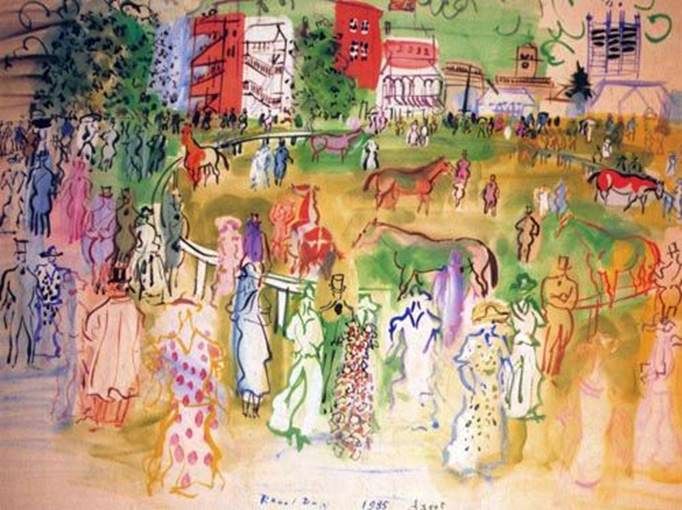
The painting was written in a manner characteristic of the late Dufi. Calligraphically accurate lines and transparent, “cloudless” tones convey the atmosphere of joyful animation and the expectation of an exciting spectacle. The figures in the foreground look slightly blurry.
Perhaps, in this way, the artist tried to show them in motion – in fact in the photos the moving figures of people also turn out to be vague. There is a feeling that the painting was written by the artist “easily and at ease,” but behind seeming ease lies a huge work, which Dufy himself called “the organization of the world around him.”
In his work, Dufy was like an experienced circus artist, following the rule – no matter what effort, sweat and blood is not worth a dizzying number, the public should not notice it. She only needs to be surprised at the ease and ease with which the gymnast soars above the arena. Horse racing in Ascot, so strikingly seen by Raoul Dufy, has long been one of the most important events in the life of high-society Britain. They owe their existence to Queen Anne, the last representative of the Stuart dynasty.
Passing in the summer of 1711 on the Windsor forest, the queen saw a wasteland that seemed to her very suitable for horse racing. Immediately an order was given to clear the wasteland of stones and shrubs, and on August 12 of the same year the first races with a prize fund of 100 guineas took place in Ascot. But in 1714 Queen Anne passed away. After her death, the newborn race track in Ascot was almost completely devastated for thirty years. Only in 1744, through the efforts of the Duke of Cumberland, the races were renewed.
In 1813, the parliament passed a decree according to which a wasteland in Ascot remained forever for horse races. And in 1820 a royal tribune was built here. But to get to the royal rostrum was possible only at the invitation of the monarch. Extremely strictly prescribed and the dress uniforms of racehorses. By 1935, when Dufy wrote his “Ascot”, these rules were no longer so strict.
There remains only one restriction – the ladies present on the escorts must necessarily wear hats. By the way, the equally popular high-society entertainment in England, than the races in Ascot, is the regatta in Henley, also captured by Dufy.
 Reception by Raoul Dufy
Reception by Raoul Dufy Ascot – Raoul Dufy
Ascot – Raoul Dufy Ascot – Raoul Dufy
Ascot – Raoul Dufy Posters in Trouville by Raoul Dufy
Posters in Trouville by Raoul Dufy Anemones by Raoul Dufy
Anemones by Raoul Dufy The great bather by Raoul Dufy
The great bather by Raoul Dufy Elephants by Raoul Dufy
Elephants by Raoul Dufy The Orchestra by Raoul Dufy
The Orchestra by Raoul Dufy